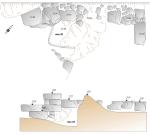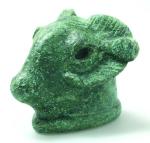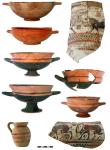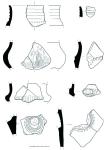Summary (English)
APOLLONIA (Krastina Panaiotova – kpanayotova@abv.bg, Margarit Damyanov, Teodora Bogdanova) The exploration of Pit No. 27 situated to the southeast of the apse of the Early Christian basilica was completed. It contained animal bones, mostly from piglets, lambs and young goats, from 2 to 6 months old, sherds of the Archaic and Classical periods and the 2nd century AD, a lead bucranium, an iron knife and a coin of Apollonia. Pit No. 27 destroyed an earlier wall in rubble masonry. In addition, the finds in the area included pre-Roman fragmentary building ceramics, sherds of Late Antique amphorae, a glass pendant showing a turtle, a cylindrical gold plate. The exploration of Grave No. 88 was completed. Three Late Antique graves were discovered: Nos. 91 and 95 with inhumation burials in pits paved with bricks, No. 94 containing two bodies and situated over an earlier destroyed wall of ashlars, probably of the Classical or Archaic period. In the Central Sector, the excavations continued in front of the Late Archaic temple of 525 – 500 BC. A pit was discovered, containing animal bones, sherds of 600 – 550 BC and a bronze arrowhead. A fragment from a terracotta plate from the frieze of the Late Archaic temple was discovered in the layer of debris in front of the building. The frieze dated to c. 500 BC and showed marching warriors. Twenty fragments from the frieze are known so far and some of them show identical images. The excavations in the interior of the Early Classical temple continued. It dated to 490 – 470 BC and was situated to the east of the Late Archaic temple. An inner wall of ashlars was excavated, separating the naos from the pronaos. The wall was built over ritual Pit No. 28, containing animal bones, a bronze figurine showing a ram’s head, 0.438 kg in weight (probably a weight of one Attic mina), sherds from two perfume figurine vessels: a head of a female figurine and the lower part of the body of a Siren, 26 – 27 ceramic cups, two olpai and one askos. Of special interest were a Chian cup decorated in the Animal Chalice Style (a bull standing against a lion), sherds from two Corinthian kotylai, a Corinthian alabastron, a North Ionian krater or dinos decorated in the Late Wild Goat Style, amphorae from Chios, Klazomenai, Lesbos and Miletos. The bothros dated to 600 – 550 BC. The latest Ionian kylikes dated to c. 550 BC and dated the closure of the ritual deposit. A pit was discovered to the south of the excavated area, containing bones from birds, oxen, goats, sheep, pigs, boars, shells and Thracian sherds of the beginning of the Early Iron Age, probably the 10th century BC, belonging to at least three kantharoi, pots, dishes and table amphorae.
- Krastina Panaiotova - Archaeological Institute with Museum
- Margarit Damyanov - Archaeological Institute with Museum
- Teodora Bogdanova - Archaeological Museum in Sozopol
Director
- Krastina Panaiotova - Archaeological Institute with Museum
- Margarit Damyanov - Archaeological Institute with Museum
- Teodora Bogdanova - Archaeological Museum in Sozopol
Team
Research Body
- Archaeological Institute with Museum
- Archaeological Museum in Sozopol






![Download [PDF]](/excavation/skins/fasti/images/results/download_sml.png)



